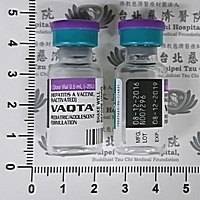藥品名稱
drug name | VAQTA 25 Unit/0.5 mL/vial (Hepatitis A Vaccine, Inactivated), 唯德不活化A型肝炎疫苗 |
| 藥檔狀態 | 使用中 |
成 份
Ingredient | Hepatitis A Vaccine |
| 單位含量 | 25U/0.5ml/vial |
| Dosage Forms | Injection, suspension [pediatric/adolescent, preservative free]: 25 units/0.5 mL |
| 外觀描述 | |
| Appearance | |
廠商名稱
Manufacturer | 美商默沙東藥廠股份有限公司台灣分公司 |
製 造 商
Manufacturer | MERCK SHARP & DOHME CORP. |
字 號
Product ID | 衛署菌疫輸字第000501號 |
藥理分類
Pharmacologic Category | Vaccine; Vaccine, Inactivated (Viral) |
作用機轉
Mechanism of action | As an inactivated virus vaccine, hepatitis A vaccine induces active immunity against hepatitis A virus infection. |
| 用途/適應症 | |
| Use |
Hepatitis A virus disease prevention:
For active immunization of persons 12 months and older against disease caused by hepatitis A virus (HAV).
The Advisory Committee on Immunization Practices (ACIP) recommends vaccination for the following (CDC/ACIP [Nelson 2020]):
— All children 12 to 23 months of age.
— All unvaccinated children and adolescents 2 through 18 years of age.
— All unvaccinated adults requesting vaccination.
— Persons≧6 months of age traveling to or working in countries with high or intermediate levels of endemic HAV infection.
— Men who have sex with men.
— Persons who use injection or noninjection illicit drugs.
— Persons with occupational risk for exposure due to work with HAV-infected nonhuman primates or HAV-containing material in a laboratory setting.
— Persons who anticipate close personal contact (eg, household contacts, babysitters) with an international adoptee from a country of intermediate to high endemicity of HAV during their first 60 days of arrival of the adoptee into the United States.
— Persons≧1 year of age experiencing homelessness.
— Persons with chronic liver disease (eg, persons with hepatitis B or C infection, cirrhosis, fatty liver disease, alcoholic liver disease, autoimmune hepatitis, ALT or AST persistently greater than twice the ULN).
— Persons≧1 year of age with HIV infection.
— Pregnant persons at risk for HAV infection or severe outcome from infection during pregnancy.
— Unvaccinated adults in settings that provide services to adults in which a high proportion have risk factors for HAV infection (eg, homeless shelters, group homes and day care facilities for persons with developmental disabilities).
— Unvaccinated persons≧12 months of age in outbreak settings, or as postexposure prophylaxis within 14 days of exposure, as determined by local public health authorities.
The Canadian National Advisory Committee on Immunization (NACI) also recommends vaccination for the following (NACI 2016):
— Persons≧6 months at risk for hepatitis A infection (eg, traveling to or from endemic countries) or severe hepatitis A (eg, underlying hepatic disease of idiopathic, metabolic, infectious or cholestatic etiology).
— Infants≧6 months living with an individual at risk for hepatitis A infection or severe hepatitis A.
— Postexposure prophylaxis:
— Healthy patients≧6 months (vaccine is preferred over immune globulin [Ig]).
— Within 14 days of exposure of susceptible adults≧60 years of age who are household or close contacts of a case (Ig may also be given).
— Susceptible individuals with chronic liver disease (Ig should also be administered within 14 days of exposure).
— May be considered in patients who receive repeat administration of plasma-derived clotting factors.
|
衛福部核准適用症狀
MOHW approved indications |
預防A型肝炎。
|
| 常用劑量 |
(藥品劑量會因人或病情增減,請依照醫師指示服用。) |
| Dose |
【Adult】
Note: Interchangeability: The Advisory Committee on Immunization Practices prefers that doses in the series come from the same manufacturer; however, if this is not possible or the previous vaccine is unknown, then may administer whichever hepatitis A vaccine is available (CDC/ACIP [Nelson 2020]).
Primary immunization: Note: When used for primary immunization, the vaccine should be given at least 2 weeks prior to expected hepatitis A virus (HAV) exposure (eg, travel to intermediate to high HAV endemicity area). When used prior to an international adoption, the vaccination series should begin when adoption is being planned, but ideally≧2 weeks prior to expected arrival of adoptee (CDC/ACIP [Nelson 2020]).
— VAQTA: IM: 1 mL (50 units) as a 2-dose series at 0 and 6 to 18 months (6 to 12 months if initial dose was with Havrix). Note: If the second dose is administered <6 months after the first dose, then a third dose administered≧6 months after the first dose is required (CDC/ACIP [Nelson 2020]).
Revaccination (CDC/ACIP [Nelson 2020]): Note: Revaccination is not recommended for healthy persons who received a complete HAV vaccine series. May consider revaccination in persons with HIV or those who received vaccination during a period of immunosuppression who had inadequate response, as determined by postvaccination serologic testing; limited data are available.
Postexposure prophylaxis (off-label use): Unvaccinated or incomplete vaccination: IM: Administer a single dose as soon as possible following recent exposure to HAV (within 14 days); for long-term protection in those previously unvaccinated, complete vaccine series with a second dose≧6 months after initial dose. Immune globulin may be indicated in select patients (eg, patients with risk factors for HAV infection or severe disease) based on provider assessment (CDC/ACIP [Nelson 2020]).
Outbreak control (off-label use): IM: Administer a single dose in all unvaccinated persons who are at risk for HAV infection or severe disease from HAV (CDC/ACIP [Nelson 2020]).
【Pediatric】
Note: Consult CDC/ACIP annual immunization schedules or National Advisory Committee on Immunization (NACI) guidelines (Canada) for additional information including specific detailed recommendations for catch-up scenarios and/or care of patients with high-risk conditions. According to ACIP, doses administered≦4 days before minimum interval or age are considered valid; however, local or state mandates may supersede this timeframe (ACIP [Kroger 2021]). Unless otherwise specified, either product may be used. ACIP prefers that doses in the series come from the same manufacturer; however, if this is not possible or the previous vaccine is unknown, then may administer whichever hepatitis A vaccine is available (CDC/ACIP [Nelson 2020]).
— Primary immunization: Note: When used for primary immunization, the vaccine should be given at least 2 weeks prior to expected hepatitis A virus (HAV) exposure (eg, travel to intermediate or high HAV endemicity area). When used prior to an international adoption, the vaccination series should begin when adoption is being planned, but at least≧2 weeks prior to expected arrival of adoptee (CDC/ACIP [Nelson 2020]).
ACIP recommendations:
Children 12 to 23 months: IM: 0.5 mL per dose for a total of 2 doses. The series should be initiated at 12 to 23 months of age. The timing of the second dose is dependent on vaccine product:
VAQTA: The second dose should be given 6 to 18 months after the first dose; if initial dose was Havrix, give second dose 6 to 12 months after first.
— Catch-up immunization: CDC (ACIP) recommendations (CDC/ACIP [Nelson 2020]): Note: Do not restart the series. If doses have been given, begin the following schedule at the applicable dose number.
Children≧2 years and Adolescents: IM: 0.5 mL per dose for a total of 2 doses separated by≧6 months.
— Revaccination (CDC/ACIP [Nelson 2020]): Note: Revaccination is not recommended for healthy persons who received a complete HAV vaccine series. May consider revaccination in persons with HIV or those who received vaccination during a period of immunosuppression who had inadequate response, as determined by postvaccination serologic testing; limited data are available, refer to "Primary Immunization" for dosing details.
— Preexposure prophylaxis, international travel (CDC/ACIP [Nelson 2020]):
Infants 6 to <12 months of age: IM: 0.5 mL once; administer as soon as travel is considered. Note: Dose does not count toward primary immunization series; at 12 months of age, the full 2-dose primary immunization hepatitis A schedule should be initiated (see "Primary Immunization").
Children and Adolescents, previously unvaccinated: IM: 0.5 mL per dose; administer first dose as soon as travel is considered; complete series according to routine schedule.
— Postexposure prophylaxis in individuals who are unvaccinated or incompletely vaccinated: Children and Adolescents: IM: 0.5 mL as soon as possible following recent exposure to HAV (within 14 days); immunocompromised individuals or those with chronic liver disease should also receive immune globulin. For long-term protection in those previously unvaccinated, complete vaccine series with a second dose≧6 months after initial dose (CDC/ACIP [Nelson 2020]).
— Outbreak control in individuals unvaccinated or incompletely vaccinated: Children and Adolescents IM: 0.5 mL per dose; administer a single dose in all unvaccinated persons who are at risk for HAV infection or severe disease from HAV (CDC/ACIP [Nelson 2020]).
【Geriatric】
Refer to adult dosing.
【Renal Impairment】
There are no dosage adjustments provided in the manufacturer’s labeling.
【Hepatic Impairment】
There are no specific recommendations provided in manufacturer’s labeling. However, data suggest patients with chronic liver disease have a lower antibody response to HAVRIX than healthy subjects.
|
懷孕分級
Pregnancy Risk Factor |
依文獻內容判定系統稽核懷孕分級建置為:C
UpToDate:
In general, maternal use of inactivated vaccines are not associated with increased risks to the fetus (ACIP [Ezeanolue 2020]). In addition, an increased risk of most adverse maternal or fetal events, including miscarriage or major birth defects, has not been observed following maternal use of the hepatitis A vaccine (Groom 2019; Nasser 2019).
The Centers for Disease Control and Prevention recommends immunization for pregnant patients at risk for hepatitis A infection or patients who are at risk for severe outcomes from infection during pregnancy (ACIP [Freedman 2020]). Refer to current immunization schedule for vaccinating pregnant females.
仿單:
VAQTA並沒有在動物身上做過生殖方面的研究。VAQTA施打於孕婦時是否會造成胎兒的傷害或是影響生殖能力,目前不得而知。除非有確切需要,否則VAQTA不宜使用在孕婦。
-----------------------------------------------------------
[FDA(美國食品及藥物管理局)懷孕分級說明:
A:對照試驗無法證實懷孕初期及後期使用會危害胎兒。
B:動物試驗無法證實對胎兒有害,但缺乏人類對照試驗;或動物試驗有副作用報告,但無法證實對懷孕初期及後期之胎兒有害。
C:動物實驗中對胎兒有害但缺乏孕婦對照實驗;或無動物及孕婦試驗。
D:證實對胎兒有害,但疾病對孕婦有生命威脅或較安全藥品無法使用或無效時可使用。
X:證實對胎兒有害,且使用後危害大於可能的益處。孕婦及可能懷孕婦女禁用。]
|
| 禁忌症 |
對本產品任何成份有過敏反應者禁用。先前曾對A型肝炎疫苗或任一疫苗成份產生嚴重反應者不可使用。
|
| Contraindications |
Immediate and/or severe allergic or hypersensitivity reaction to hepatitis A containing vaccines or any component of the formulation, including neomycin.
|
| 常見副作用 | |
| Common adverse drug reactions | |
| Adverse Reactions |
The following adverse drug reactions and incidences are derived from product labeling unless otherwise specified. Frequency dependent upon age, product used, and concomitant vaccine administration. In general, headache and injection site reactions were less common in younger children.
>10%:
Central nervous system:Drowsiness, headache, irritability
Gastrointestinal:Decreased appetite
Local:Erythema at injection site, injection site reaction (soreness, warmth), pain at injection site, swelling at injection site, tenderness at injection site
Neuromuscular & skeletal:Weakness
Miscellaneous:Fever (≧100.4°F [1-5 days postvaccination], >98.6°F [1-14 days postvaccination])
1% to 10%:
Central nervous system:Chills, fatigue, insomnia, malaise
Dermatologic:Skin rash
Endocrine & metabolic:Menstrual disease
Gastrointestinal:Abdominal pain, anorexia, constipation, diarrhea, gastroenteritis, nausea, vomiting
Local:Bruising at injection site, induration at injection site
Neuromuscular & skeletal:Arm pain, back pain, myalgia, stiffness
Ophthalmic:Conjunctivitis
Otic:Otitis media
Respiratory:Asthma, cough, nasal congestion, nasopharyngitis, pharyngitis, rhinitis, rhinorrhea, upper respiratory tract infection
Miscellaneous:Excessive crying, fever≧102°F (1-5 days postvaccination)
<1%,
postmarketing, and/or case reports: Anaphylaxis, angioedema, arthralgia, ataxia (cerebellar), bronchiolitis, bronchoconstriction, croup, dehydration, dermatitis, dizziness, dysgeusia, dyspnea, encephalitis, erythema multiforme, eye irritation, flu-like symptoms, Guillain-Barre syndrome, hematoma at injection site, hepatitis, hyperhidrosis, hypersensitivity reaction, hypertonia, hypoesthesia, increased creatine kinase, increased serum transaminases (transient), injection site reaction (nodule), insomnia, jaundice, lymphadenopathy, multiple sclerosis, myelitis, neuropathy, otitis, paresthesia, photophobia, pneumonia, pruritus, rash at injection site, respiratory congestion, seizure, serum sickness-like reaction, syncope, thrombocytopenia, urticaria, vasculitis, vertigo, viral exanthem, wheezing
|
★高警訊藥品
監測建議 |
|
監測
Monitoring |
Monitor for anaphylaxis and syncope for 15 minutes following administration (ACIP [Kroger 2021]). If seizure-like activity associated with syncope occurs, maintain patient in supine or Trendelenburg position to reestablish adequate cerebral perfusion.
Pre- and postvaccination serologic testing are not recommended routinely but may be considered in certain settings. Postvaccination serologic testing may be warranted in patients with HIV or those persons who received hepatitis A vaccination while immunosuppressed from chemotherapy (CDC/ACIP [Nelson 2020]).
|
| 警語與注意事項 | |
| Warnings & precautions | |
| 針劑溶解條件 |
|
| 針劑稀釋條件 |
|
| 針劑不相容性 |
如必須與其他疫苗或免疫球蛋白併用,應以不同注射針筒及針頭在不同注射部位施打。(1051027仿單資料)
|
| 針劑施打條件 |
採肌肉注射方式,並應注射於成人或孩童的三角肌部位,嬰兒則應注射於大腿前外側部位。不可血管內、皮內或皮下注射。(1051027仿單資料)
|
| 針劑保存安定性 |
須存放於2-8℃。(1051027仿單資料)
|
最近修改日期時間
Updated | 6/1/2021 10:38:34 AM |
|

現用藥品
Available
|

停用藥品
Old item
|

藥品仿單
DrugLabeling
|

二維條碼
QR code
|
|